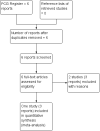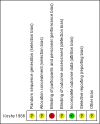Prophylactic versus selective blood transfusion for sickle cell disease in pregnancy
- PMID: 28005272
- PMCID: PMC6463955
- DOI: 10.1002/14651858.CD010378.pub3
Prophylactic versus selective blood transfusion for sickle cell disease in pregnancy
Abstract
Background: Pregnant women with sickle cell disease (HbSS, HbSC and HbSβThal) may require blood transfusion to prevent severe anaemia or to manage potential medical complications. Preventive blood transfusion in the absence of complications starting from the early weeks of pregnancy or blood transfusion only for medical or obstetric indications have been used as management policies. There is currently no consensus on the blood transfusion policy that guarantees optimal clinical benefits with minimal risks for such women and their babies. This is an update of a Cochrane review that was published in 2013.
Objectives: To assess the benefits and harms of a policy of prophylactic versus selective blood transfusion in pregnant women with sickle cell disease.
Search methods: We searched the Cochrane Pregnancy and Childbirth Group's Trials Register (30 May 2016) and reference lists of retrieved studies. We did not apply any language or date restrictions.
Selection criteria: Randomised controlled trials evaluating the effects of prophylactic versus selective (emergency) blood transfusion in pregnant women with sickle cell disease (SCD). Quasi-randomised trials and trials using a cluster-randomised design were eligible for inclusion but none were identified.
Data collection and analysis: Two review authors independently assessed trials for inclusion and risk of bias, extracted data and checked them for accuracy. Two review authors independently assessed the quality of the evidence using the GRADE approach.
Main results: Out of six relevant reports identified by the search strategy, one trial involving 72 women with sickle cell anaemia (HbSS) met our inclusion criteria. The trial was at unclear risk of bias. Overall, there were few events for most of the reported outcomes and the results were generally imprecise. The included trial reported no maternal mortality occurring in women who received either prophylactic or selective blood transfusion. Very low-quality evidence indicated no clear differences in maternal mortality, perinatal mortality (risk ratio (RR) 2.85, 95% confidence interval (CI) 0.61 to 13.22; very low-quality evidence) or markers of severe maternal morbidity (pulmonary embolism (no events); congestive cardiac failure (RR 1.00, 95% CI 0.07 to 15.38; very low-quality evidence); acute chest syndrome (RR 0.67, 95% CI 0.12 to 3.75)) between the treatment groups (prophylactic blood transfusion versus selective blood transfusion). Low-quality evidence indicated that prophylactic blood transfusion reduced the risk of pain crisis compared with selective blood transfusion (RR 0.28, 95% CI 0.12 to 0.67, one trial, 72 women; low-quality evidence), and no differences in the occurrence of acute splenic sequestration (RR 0.33, 95% CI 0.01 to 7.92; low-quality evidence), haemolytic crises (RR 0.33, 95% CI 0.04 to 3.06) or delayed blood transfusion reaction (RR 2.00, 95% CI 0.54 to 7.39; very low-quality evidence) between the comparison groups.Other relevant maternal outcomes pre-specified for this review such as cumulative duration of hospital stay, postpartum haemorrhage and iron overload, and infant outcomes, admission to neonatal intensive care unit (NICU) and haemolytic disease of the newborn, were not reported by the trial.
Authors' conclusions: Evidence from one small trial of very low quality suggests that prophylactic blood transfusion to pregnant women with sickle cell anaemia (HbSS) confers no clear clinical benefits when compared with selective transfusion. Currently, there is no evidence from randomised or quasi-randomised trials to provide reliable advice on the optimal blood transfusion policy for women with other variants of sickle cell disease (i.e. HbSC and HbSβThal). The available data and quality of evidence on this subject are insufficient to advocate for a change in existing clinical practice and policy.
Conflict of interest statement
Babasola O Okusanya: none known.
Olufemi T Oladapo: none known.
Figures












Update of
-
Prophylactic versus selective blood transfusion for sickle cell disease in pregnancy.Cochrane Database Syst Rev. 2013 Dec 3;(12):CD010378. doi: 10.1002/14651858.CD010378.pub2. Cochrane Database Syst Rev. 2013. Update in: Cochrane Database Syst Rev. 2016 Dec 22;12:CD010378. doi: 10.1002/14651858.CD010378.pub3. PMID: 24297507 Updated.
References
References to studies included in this review
Koshy 1988 {published data only}
-
- Koshy M, Burd L, Dorn L, Huff G. Frequency of pain crisis during pregnancy. Progress in Clinical and Biological Research 1987;240:305‐11. - PubMed
-
- Koshy M, Burd L, Wallace D, Moawad A, Baron J. Prophylactic red‐cell transfusions in pregnant patients with sickle cell disease. New England Journal of Medicine 1988;319:1447‐52. - PubMed
-
- Koshy M, Burd L, Wallace D, Moawad A, Baron J. Prophylactic red‐cell transfusions in pregnant patients with sickle cell disease. A randomised cooperative study. International Journal of Gynecology and Obstetrics 1989;29:227‐8. - PubMed
References to studies excluded from this review
Cerqueira 1999 {published data only}
-
- Cerqueira E, Azevedo FC, Lobo C, Carrano A, Boukai R. Transfusional management in pregnant patients with sickle cell disease [abstract]. The National Sickle Cell Disease Program 23rd Annual Meeting Conference Proceedings; 1999 March 6‐9; San Francisco, California, USA. 1999:74.
-
- Marques de Azevedo. Transfusion management of pregnant sickle cell patients [abstract]. Transfusion 1999;39:108S.
Koshy 1991 {published data only}
-
- Koshy M, Chisum D, Burd L, Orlina A, How H. Management of sickle cell anemia and pregnancy. Journal of Clinical Apheresis 1991;6:230‐3. - PubMed
Additional references
ACOG 2007
-
- American College of Obstetrics and Gynecology (ACOG). Hemoglobinopathies in pregnancy. Practice bulletin Number 78 2007. - PubMed
Afolabi 2009
-
- Afolabi BB, Iwuala NC, Iwuala IC, Ogedengbe OK. Morbidity and mortality in sickle cell pregnancies in Lagos, Nigeria: a case control study. Journal of Obstetrics and Gynaecology 2009;29(2):104‐6. - PubMed
Asnani 2011
Barfield 2010
-
- Barfield WD, Barradas DT, Manning SE, Kotelchuck M, Shapiro‐Mendoza CK. Sickle cell disease and pregnancy outcomes, women of African descent. American Journal of Preventive Medicine 2010;38(4S):S542‐S549. - PubMed
Boga 2016
-
- Boga C, Ozdogu H. Pregnancy and sickle cell disease: A review of current literature. Critical Reviews in Oncology/hematology 2016;98:364‐74. - PubMed
Cunningham 1983
-
- Cunningham FG, Pritchard JA, Mason R. Pregnancy and sickle cell hemoglobinopathies: results with and without prophylactic transfusion. Obstetrics and Gynecology 1983;62(4):419‐24. - PubMed
Gilli 2007
-
- Gilli SC, Paula EV, Biscaro FP, Marques JF, Costa FF. Third‐trimester erythrocytapheresis in pregnant patients with sickle cell disease. International Journal of Gynecology and Obstetrics 2007;96(1):8‐11. - PubMed
Grossetti 2009
-
- Grossetti E, Carles G, Guindi W, Seve B, Montoya Y, Creveuil C, et al. Selective prophylactic transfusion in sickle cell disease. Acta Obstetricia et Gynecologica Scandinavica 2009;88(10):1090‐4. - PubMed
Hassel 2010
-
- Hassel KL. Population estimates of sickle cell disease in the US. American Journal of Preventive Medicine 2010;38(4S):S512‐S521. - PubMed
Higgins 2011
-
- Higgins JPT, Green S, editors. Cochrane Handbook for Systematic Reviews of Interventions Version 5.1.0 [updated March 2011]. The Cochrane Collaboration, 2011. Available from www.cochrane‐handbook.org.
Hoffbrand 2011
-
- Hoffbrand AV, Moss PAH. [Genetic disorders of haemoglobin. In Essential Haematology]. In: Hoffbrand AV, Moss PAH editor(s). Genetic disorders of haemoglobin. In Essential Haematology. 6th Edition. Chichester, West Sussex, UK: Wiley‐Blackwell, 2011:88‐107.
Howard 1995
-
- Howard RJ, Tuck SM, Pearson TC. Pregnancy in sickle cell disease in the UK: results of a multicentre survey of the effect of prophylactic blood transfusion on maternal and fetal outcome. British Journal of Obstetrics and Gynaecology 1995;102:947‐51. - PubMed
Koshy 1987
-
- Koshy M, Burd L, Dorn L, Huff G. Frequency of pain crisis during pregnancy. Progress in Clinical and Biological Research 1987;240:305‐11. - PubMed
Makani 2007
Malinowski 2015
-
- Malinowski AK, Shehata N, D'Souza R, Kuo KHM, Ward R, Shah PS, et al. Prophylactic transfusion for pregnant women with sickle cell diease: a systematic review and meta‐analysis. Blood 2015;126(21):2424‐35. - PubMed
Marti‐Carvajal 2009
Ngo 2010
-
- Ngo C, Kayem G, Habibi A, Benachi A, Goffinet F, Galacteros F, et al. Pregnancy in sickle cell disease: maternal and fetal outcomes in a population receiving prophylactic partial exchange transfusions. European Journal of Obstetrics, Gynecology, and Reproductive Biology 2010;152:138‐42. - PubMed
Nomura 2009
Odum 2002
-
- Odum CU, Anorlu RI, Dim SI, Oyekan TO. Pregnancy outcome in HbSS sickle cell disease in Lagos, Nigeria. West African Journal of Medicine 2002;21(1):19‐23. - PubMed
RCOG 2011
-
- Royal College of Obstetrics and Gynaecology (RCOG). Management of sickle cell disease in pregnancy. Green‐top Guideline No:61 2011.
RevMan 2014 [Computer program]
-
- The Nordic Cochrane Centre, The Cochrane Collaboration. Review Manager (RevMan). Version 5.3. Copenhagen: The Nordic Cochrane Centre, The Cochrane Collaboration, 2014.
Serjeant 2004
-
- Serjeant GR, Loy LL, Crowther M, Hambleton IR, Thame M. Outcome of pregnancy in homozygous sickle cell disease. Obstetrics and Gynecology 2004;103:1278‐85. - PubMed
Serjeant 2005
-
- Serjeant GR, Hambleton I, Thame M. Fecundity and pregnancy outcome in a cohort with sickle cell haemoglobin C disease followed from birth. BJOG: an international journal of obstetrics and gynaecology 2005;112:1308‐14. - PubMed
References to other published versions of this review
Mahomed 2006
Okusanya 2013a
Publication types
MeSH terms
Grants and funding
LinkOut - more resources
Full Text Sources
Other Literature Sources
Medical
Miscellaneous

